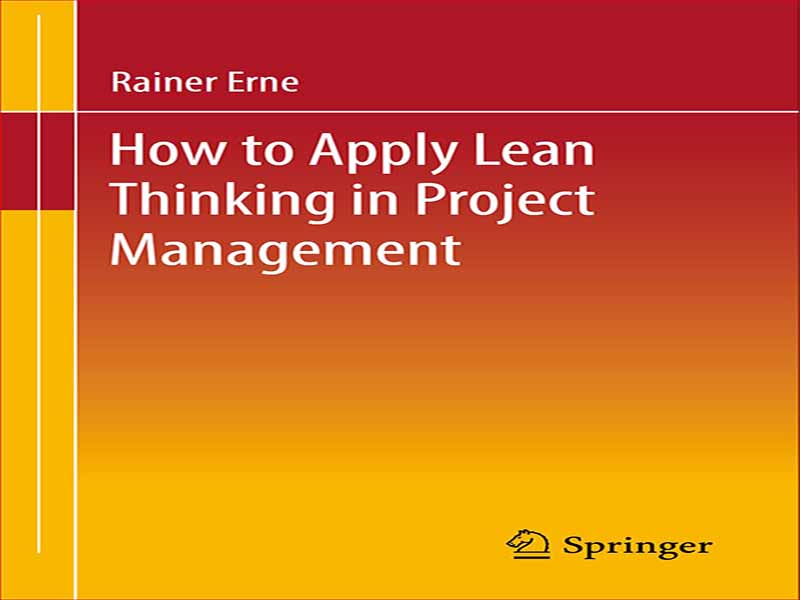- عنوان: How to Apply Lean Thinking in Project Management
- نویسنده: Rainer Erne
- حوزه: مدیریت پروژه
- سال انتشار: 2022
- تعداد صفحه: 226
- زبان اصلی: انگلیسی
- نوع فایل: pdf
- حجم فایل: 5.61 مگابایت
طبق پیشبینی موسسه مدیریت پروژه (2017b)، مشاغل مبتنی بر پروژه بین سالهای 2017 تا 2027 به طور متوسط 33 درصد در کشورهایی مانند آلمان، بریتانیا، ایالات متحده، چین و هند افزایش خواهند یافت. این بدان معناست که در سال 2027 تقاضای جهانی برای حدود 87.7 میلیون کارگر پروژه در صنایعی مانند ساخت و ساز، فناوری اطلاعات، مراقبت های بهداشتی، خدمات مالی و انرژی وجود خواهد داشت. اهمیت فزاینده مدیریت پروژه در 60 سال گذشته ابتدا با ایجاد انجمن های مدیریت پروژه پاسخ داده شده است: در پایان دهه 1960 در ایالات متحده آمریکا (به موسسه مدیریت پروژه 2017a مراجعه کنید) و در اروپا (به انجمن بین المللی مدیریت پروژه 2016 مراجعه کنید. –c)، و 30 سال بعد به علاوه PRINCE2 در بریتانیا (به Axelos و TSO 2017 مراجعه کنید). این انجمن ها همگی گواهینامه های مدیریت پروژه متفاوتی را با توجه به استانداردهای مربوطه ارائه می دهند – در عین حال در هر دو رویکرد “کلاسیک” و “چابک”. ثانیاً، استانداردسازی مدیریت پروژه در همان دوره پدیدار شد. در آلمان، هنجار خاص کشور DIN 69901: Project Management—Project Management Systems در پنج جلد (2016a–e) وجود دارد و استاندارد DIN ISO 21500 “Project Management Guidelines” (2016) کل منطقه بین المللی را شامل می شود. ثالثاً یک زمینه گیج کننده از تک نگاری ها، گزارش ها، جزوه ها و نسخه ها در مورد مدیریت پروژه ایجاد شده است. این میزان به ویژه در سال های اخیر با ظهور مدیریت پروژه فناوری اطلاعات و مدل های چابک افزایش یافته است. تک نگاری های پرخواننده اسکات برکون (2008)، جف ساترلند (2014)، اریک ورزوه (2016)، هارولد کرزنر (2017)، جرولد پاتزاک و گونتر راتای (2018)، یا یورگ کوستر و همکاران. (2019) را می توان در اینجا به عنوان نمونه ذکر کرد. چهارم، مدیریت پروژه همچنین در آموزش و پژوهش از یک زیرشاخه مهندسی به یک زمینه مستقل و فرا رشته ای تحقیقاتی و آموزشی در مدارس و دانشگاه ها توسعه یافته است. در حال حاضر، این شاخه، در میان چیزهای دیگر، با این سوال که چگونه تنوع در مدیریت پروژه را می توان به صورت نظری و عملی توصیف، توضیح و پردازش کرد، درگیر است (به Padalkar and Gopinath 2016؛ Uchitpe et al. 2016 مراجعه کنید). از این رو مدیریت پروژه را میتوان به عنوان یک حرفه بین بخشی در نظر گرفت که دارای انجمنهای حرفهای و همچنین دانش حرفهای استاندارد و قابل آزمایش است که دائماً در حال تغییر است (نگاه کنید به Millerson 1964؛ Mieg 2003). بر اساس مشاهدات فوق این سؤال مطرح می شود: چرا یک اضافی؟
According to a forecast by the Project Management Institute (2017b), project-based jobs will increase by 33% on average between 2017 and 2027 in countries like Germany, the UK, the US, China and India. This means that in 2027 there will be a global demand for around 87.7 million project workers in industries such as construction, information technology, healthcare, financial services and energy. The growing importance of project management over the past 60 years has been responded to firstly by the establishment of project management associations: at the end of the 1960s in the USA (see Project Management Institute 2017a) and in Europe (see International Project Management Association 2016a–c), and 30 years later additionally PRINCE2 in the UK (see Axelos and TSO 2017). These associations all offer different project management certifications according to the respective standards they administer—meanwhile in both “classic” and “agile” approaches. Secondly, standardization on project management emerged during the same period. In Germany, the country-specific norm DIN 69901: Project Management— Project Management Systems exists in five volumes (2016a–e), and the norm DIN ISO 21500 “Project Management Guidelines” (2016) comprise the entire international area. Thirdly a meanwhile confusing field of monographs, reports, handouts and prescriptions on project management has developed. The amount has especially grown in recent years with the emergence of IT project management and agile models. The widely read monographs by Scott Berkun (2008), Jeff Sutherland (2014), Eric Verzuh (2016), Harold Kerzner (2017), Gerold Patzak and Günter Rattay (2018), or Jürg Kuster et al. (2019) can be mentioned here as examples. Fourthly, project management has also developed in teaching and research from a sub-discipline of engineering to an independent, transdisciplinary research and teaching field at schools and universities. At the moment, this branch is concerned, among other things, with the question of how variability in project management can be theoretically and practically described, explained and processed (see Padalkar and Gopinath 2016; Uchitpe et al. 2016). Hence project management can by now be regarded as a cross-sector profession that has professional associations as well as a standardized and testable professional knowledge that is constantly evolving (see Millerson 1964; Mieg 2003). Based on abovementioned observation the question is: Why an additional
این کتاب را میتوانید بصورت رایگان از لینک زیر دانلود نمایید.




































نظرات کاربران